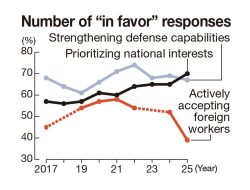
The restroom designed by Nigo in Harajuku, Tokyo, which is part of The Tokyo Toilet project
10:30 JST, July 2, 2021
Since August last year, a curious little project called The Tokyo Toilet has been underway on the streets of Tokyo. Spearheaded by the Nippon Foundation, the project plans to install 17 public restrooms in Shibuya Ward, with the aim of creating a more inclusive society that embraces diversity.
An international cast of 16 creators has been tapped to design the lavish lavatories. In addition to big-name architects such as Tadao Ando, Toyoo Ito and Kengo Kuma, a number of prominent fashion designers have also signed onto the project.
Of particular note to fashionistas is the restroom designed by Nigo, which opened its doors on Meiji-dori avenue in Harajuku on May 31.
Nigo, 50, made his name as a charismatic doyen active in the “Ura-Harajuku” or backstreet Harajuku scene, along with other famed designers such as Jun Takahashi, whose Undercover brand has become a fixture at Paris Fashion Week, and Hiroshi Fujiwara, a designer and DJ in demand as a high-profile collaborator.
Whereas Harajuku is the flashy fashion capital of Tokyo, synonymous with the Takeshitadori and Omotesando promenades, Ura-Harajuku — “Ura-Hara,” for short — refers to the edgier boutiques and brands that appeared around Cat Street, when the mostly pedestrian path was constructed in 1994. But as many of the original shops have since shuttered their doors or moved on, the word Ura-Hara has gradually become a thing of the past.
Nigo is revered as the father of the Ura-Hara fashion brand A Bathing Ape, which remains arguably the most acclaimed of the many brands he has launched to date. Although he sold the brand to the Hong Kong conglomerate I.T, he is still going strong at the helm of his new label Human Made, while serving as the creative director for Uniqlo’s T-shirt brand, UT, and DJ-ing with the hip-hop group Teriyaki Boyz. He also somehow finds the time to manage the Curry Up curry restaurants in Kita-sando and Naka-meguro in Tokyo, which were christened by none other than Pharrell Williams.

The new Maserati Ghibli designed in collaboration with street culture icon Hiroshi Fujiwara
For his contribution to The Tokyo Toilet project, Nigo drew inspiration from the idiom “onkochishin,” meaning to learn from the past to discover new things. Looking more like a quaint homesteader’s abode than a lavatory, complete with retro peppermint green doorframes and windows, the structure has a toyish, dollhouse quality that is quintessentially Nigo. The door on the left leads to the men’s restroom, the middle is wheelchair-accessible, and the right is for women. A word to the wise: the stylized stick-figure icons denoting the genders are a bit cryptic, so double-check before barging into the wrong entrance.
The name “Nigo” is a pseudonym, bestowed on the artist because of his resemblance to Fujiwara, who is 57 years old. The word nigo is Japanese for “the 2nd.”
Fujiwara wears many hats: DJ, musician, music producer and fashion designer. Fashion-conscious folks from the “dankai junior” generation — as the children of baby-boomers are sometimes referred to in Japanese — were all influenced by Nigo and Fujiwara in one way or another in the 1990s, whether through fashion magazines or media appearances. This demographic cohort has now reached their late 40s, but they still have a special place in their hearts for Nigo and Fujiwara.
Fujiwara is much sought-after for collaborative projects, to the extent that collaborations have become his main bread and butter, even as he runs his fashion brand Fragment Design.
He has joined forces with many celebrated brands, from high-end maisons such as Louis Vuitton, Bvlgari, Tag Heuer, Baccarat and Moncler, to contemporary labels like Sacai and Undercover, as well as brands such as Nike, Levi’s, Stussy, Burton, Starbucks and Polaroid.
One recent gig even had him designing school uniforms for boys and girls at a private secondary school.
What is the secret to Fujiwara’s unfading fandom?
Go visit the store the day his next collaboration launches, and you will undoubtedly find a long line of cognoscenti, eager to get their hands on his latest creation. No longer just the charisma of Ura-Hara, Fujiwara is now the reigning king of collaboration.
Fujiwara has been working on his first collaboration with Italian automaker Maserati, veritable royalty in the luxury car world.
“Fragment Design x Maserati” gives the Japanese street culture pioneer a perfect canvas in the carmaker’s first hybrid vehicle, the Ghibli Hybrid. You could call it the king of collaboration’s crowning achievement.

Akira Miura
Miura is a journalist and a former editor in chief of WWD Japan.
"Culture" POPULAR ARTICLE
-

Dior, Gucci Adapt Kyoto’s Traditional Textiles for Modern Tastes
-

Event Held at Kyoto State Guest House to Showcase Beauty of Traditional Japan, Includes Crafts, Cuisine, Performances
-

Van Cleef & Arpels Dazzles with Art Deco Artisanry at Tokyo Exhibit
-

Ainu Thanksgiving Festival to Be Held in Tokyo with Performances from Ainu, Other Indigenous Groups
-

Disney’s ‘Twisted-Wonderland’ Animated Series Puts Villains in Spotlight: New Show Features School Inspired by Classic Disney Films
JN ACCESS RANKING
-

Govt Plans to Urge Municipalities to Help Residents Cope with Rising Prices
-

Japan Resumes Scallop Exports to China
-

Japan Prime Minister Takaichi Vows to Have Country Exit Deflation, Closely Monitor Economic Indicators
-

Japan to Charge Foreigners More for Residence Permits, Looking to Align with Western Countries
-

JR East Suica’s Penguin to Retire at End of FY2026; Baton to be Passed to New Character





















